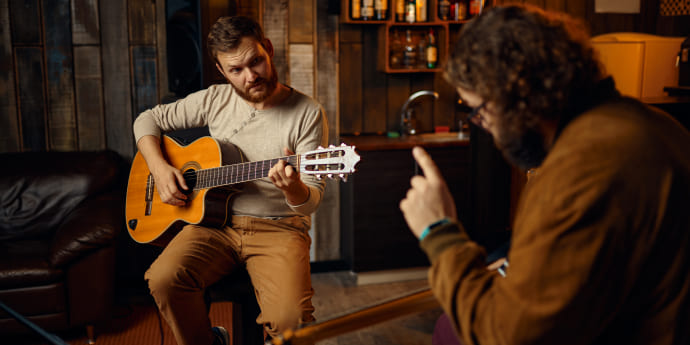How to improvise on guitar is one of the most rewarding aspects of learning to play the guitar. This is where you can start expressing yourself and making the guitar sound the way you want. It is a great feeling to play the guitar in your head.

Many styles of music, especially rock, blues, and jazz, are built around guitarists, both solo and throughout the song. Before you start improvising, make sure you have the basics of music theory, including scales and chords and how they work together.
You can learn many things, and you can also buy the best guitar brand according to your choice. If you want to learn guitar improvisation, all you need is training in breakthrough guitar and after some practice, follow the steps on how to improvise on guitar.
8 Simple Steps to Improvise Guitar
1. Learn the Names of Low E String
To become a skilled guitar player, you should learn guitar improvisation and names of all the notes on the guitar fretboard and improvise on your instrument easily. However, to start improvising on the guitar using the approach, you only need to memorize the notes on the low E string. It is also the best way to make progress in learning guitar.
2. Learn About Minor & Major Pentatonic
Learning scales (and modes) will give you a plethora of options and flavors to choose from and let you improve your licks and solo while using these options. If you learn those scales in various places and piece them together, you will be able to play anywhere on the fretboard. However, controlling the major and minor pentatonic scales in just one position allows you to learn to improvise on guitar with almost any background music at your disposal. After remembering these two patterns and trying them out in various keys, you should experiment with your improvised guitar solo. This is also the best way to learn guitar scales and explore them.
For the time being, start playing more complex notes than just moving the scale up and down the fretboard and attempting to create a melody.
3. Become Familiar with Arpeggio
Arpeggios are crucial in improvisation because they inform you which notes you should emphasize and which ones you should neglect. You might select to study the theory behind scales and arpeggios to improve your guitar improvisation skills. However, to get started in guitar improvisation, all you need to know is that an arpeggio is made up of the first, third, and fifth notes of a major or minor scale.
If you are interested in taking your improvements to another level, you need to know what you are doing and why. Although, you shouldn’t wait until you’ve learned all the principles before producing your own improvisation. These are the notes of the minor or major pentatonic scales that you should spend more time improvising on the guitar as these are the most prolonged notes in the scale.
4. Improvise Using a Note
The dispute of this exercise is to play something exciting, even though you only have one note. So, what other weapons do you have? An important one is rhythm. Try to create a rhythm that fits well with the backing track and repeat it. Also, try to play with soft and loud notes. Finally, don’t be afraid to skip long breaks.
Just choose a note that you like. If it sounds terrible at any point, just fret up or down, and you’ll get a note that sounds a lot better. For now, though, try this track and only play the sixth fret on the high E string.
5. Improvise Using Two Notes
If possible, do the same as in the first exercise, but now use two notes. For the track below, use the 3rd and 6th fret on the high E string. Keep in mind that you can still replicate the same note many times, and you do not have to go back and forth among the first and second notes every time.
6. Stick to Four Notes
Add notes on the 3rd and 6th fret on both the B string and the high E string. You will now have four notes. First, play each note individually and remember which pitch corresponds to which fret. See if you can sing along to each note as you play it.
What can you do with these four notes? Do not forget the first two exercises though! Use pauses and rhythm. Repeat the same note several times before moving on to the next note. And do not forget to play with soft and loud notes. Also, try starting by repeating only the lowest note (i.e., the 3rd fret on the B string) and adding the other notes one by one.
7. Make a Simple Phrase and Play Around with it
Make a simple phrase using the third and sixth frets on both the b string and the high E string. It does not have to be spectacular; anything will do. Now play the chord progression one more time (0:20 to 1:21 in the backing track below), where you try to repeat just that one phrase. Remember you can play with time.
After that, try it again, but for now, try adding a note or two before your phrase. After that, do the same thing but add a note or two after your phrase. And this is how your guitar learning progression will take speed to another level.
8. String Put on a Track and Stick to a Single
Proceed with this process until you have about five notes that sound great and try to improvise using only those notes. After some time, you may want to add a few more notes, but remember that there are generally only seven notes on each string that sound great.
Pick a guitar string now put it on a track and play any note on that string. If you think it sounds okay, memorize that note and play the next note. If you do not think it sounds good, slide the fret up or down, and you will get an excellent sounding note.
Note– If you are buying a guitar, then know a few things about guitar strings before buying it.
Ten Ways to Improve Your Playing
How to get better at guitar? Here are ten things you can do that will immediately make a difference when you play.
- Practice at Regular Times Each Day
- Practice with a Metronome.
- Make sure every note you play is played correctly.
- Define what you want to achieve
- Buy a Guitar Book and go through It Systematically
- Record Yourself Playing
- Seek inspiration
- Transcribe Music
- Get lessons
- Play in Public
How to Play Lead Guitar?
We will show you how to play lead guitar through 7 step process, which you can repeatedly repeat, each time adding new musical components and skills until you reach the level of lead guitarist.
Step 1: Learn one scale- The initial step toward learning to play lead guitar is so easy as learning one of these scales, the minor pentatonic, in just one position on the guitar’s neck.
Step 2: Apply scale sequences- Scale sequences help you learn the scale better and give you tips on how to use it in separate ways instead of going up and down in succession.
Step 3: Learn a phrasing technique- Lead guitar players continually implement vibrato, slide, hammer-on and pull-off, string bending, pinch harmonics, and rake to spice up their solos. And for the best spice-up, you must follow guitar solos tricks and tips.
Step 4: Learn guitar licks- As long as you have an idea of the most basic components of lead guitar playing, it is time to start putting them into practice. Begin building a vocabulary of guitar licks that uses your learning techniques.
Step 5: Integrate lead guitar elements- Now that you have the most fundamental aspects of lead guitar playing below your belt, time to begin merging them. To do this, we’re just going to take a snippet from the sequence of the first scale in Step 2.
Step 6: Create your lead guitar licks- The way I lick a snippet by combining a phrasing technique from a scale sequence is very mechanical, and guitar players don’t really improvise that way.
Step 7: Do the procedure again and add new lead guitar elements- The last 6 steps show you the process of learning to play lead guitar. This move is a way to rise above the fundamentals and keep improving. Come back to Step 1 and either learn a new scale or learn the same scale in a new position on the neck of the guitar. Then apply the scale sequence to this new scale pattern that you are learning.
So, these are the best ways to learn chords on guitar. Follow these steps and upgrade yourself to the next level.
Conclusion
Improvisation doesn’t mean memorizing songs or solos from your favorite songs and playing them randomly to some accompaniment. Being able to extemporize means producing creative ideas from the moment music plays.
We hope now you are clear about how to improvise on the guitar and hope so; this blog has partially answered your questions about how to improvise and gives you valuable instructions for practicing improvisation.









